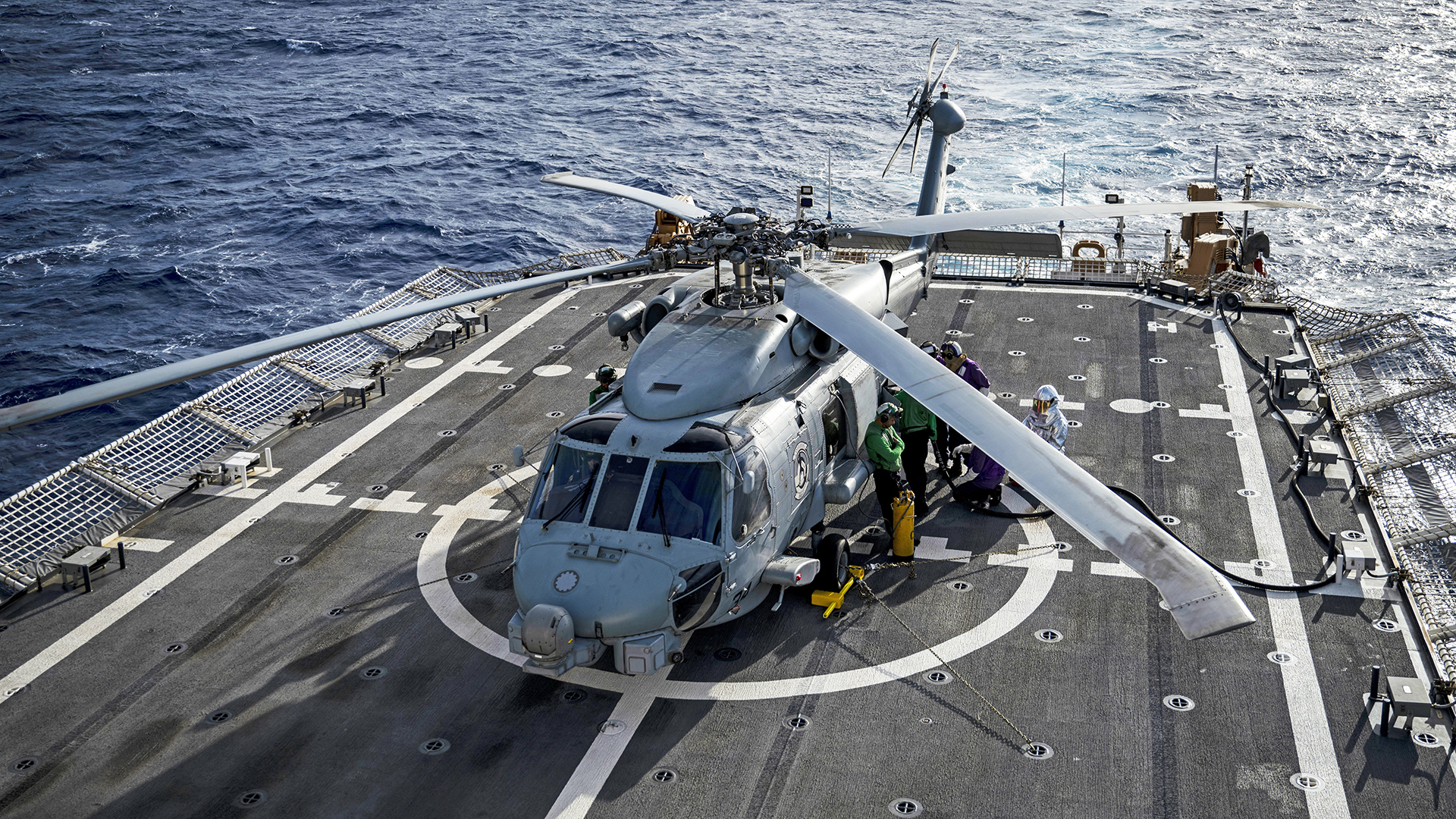When a U.S. Navy MH-60R Seahawk helicopter landed on the flight deck of the U.S. Coast Guard Legend-class National Security cutter Midgett last month during the biennial Rim of the Pacific (RIMPAC) exercise, it marked a turning point for both services.
And it came as the U.S. military is working toward distributed maritime operations across wide swaths of ocean, especially to counter a Chinese Navy that is set to become markedly larger than its American counterpart, and also enjoys a home field advantage in the Western Pacific.
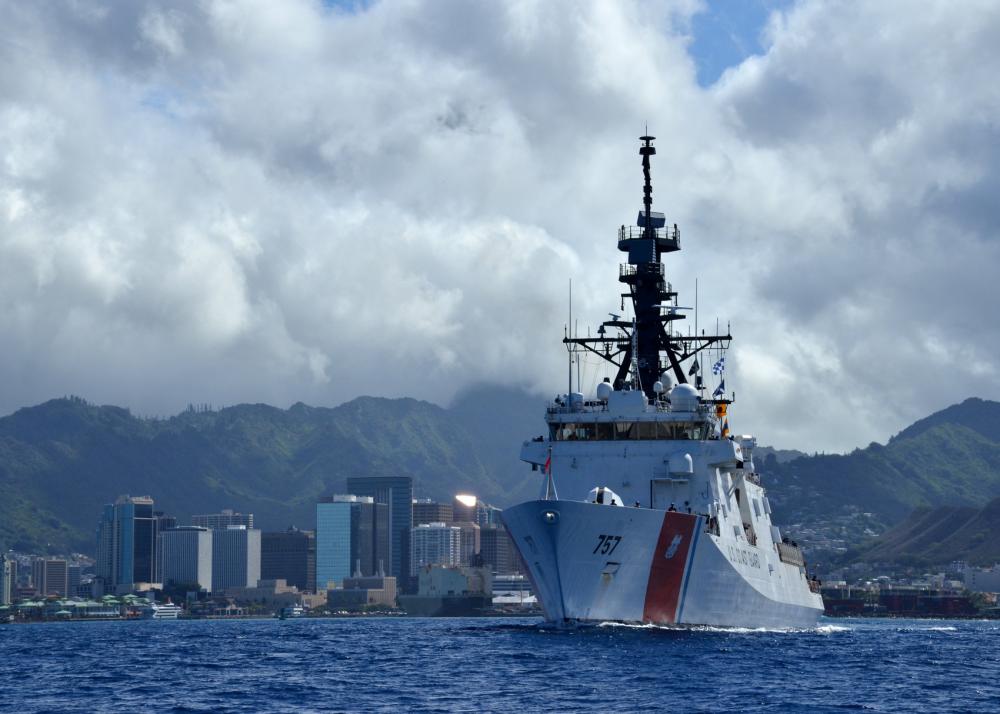
The RIMPAC exercise marked the first time a Coast Guard Cutter led a combined task force, the first time there was modern Coast Guard participation in anti-submarine warfare exercises, and the first time a ‘Romeo’ variant of the MH-60 embarked aboard a U.S. Coast Guard vessel, a significant event considering what the helicopter brings to the table.
The MH-60R is the latest anti-submarine warfare/multi-role evolution of the Sikorsky SH-60 Seahawk, which is a navalized derivative of the UH-60 Black Hawk.

Beyond their primary anti-submarine role, these helicopters can also support boarding operations and special operations forces missions. In recent years, they have also taken on an increasing close-in defense role against potential attacks from swarms of small boats. They’re also set to gain an electronic warfare role with the integration of the Advanced Offboard Electronic Warfare (AOEW) pod, which you can read about more here.
Here is some highlights of what they are equipped with:
- Second generation integrated Raytheon AN/AAS-44 forward-looking infrared (FLIR) system for expanded night and inclement weather vision and Hellfire targeting capability
- APS-147 multi-mode radar capable of high-resolution inverse Synthetic Aperture Radar imaging and periscope detection
- Integrated AQS-22 Airborne Low-Frequency Sonar with expanded littoral and deep-water capability, including concurrent dipping sonar and sonobuoy processing capability and sonobuoy stores
- military-off-the-shelf (MOTS) based mission and flight management computers
- advanced ALQ-210 Electronic Support Measures (ESM) system for passive detection of radiofrequency signals, including the ability to geo-locate and identification of emitters
- sensor data integrated into actionable information provides threat assessments for superior situational awareness of the digital battlefield
- data link for radar, FLIR, voice, acoustics, ESM and mission display
Most everything the MH-60R detects is immediately transmitted back to Navy ships via the Common Data Link (CDL) “Hawklink.” As for the Midgett, the Coast Guard told The War Zone is passed from the Romeo through an “integrated tactical data link” but did not specify which one.
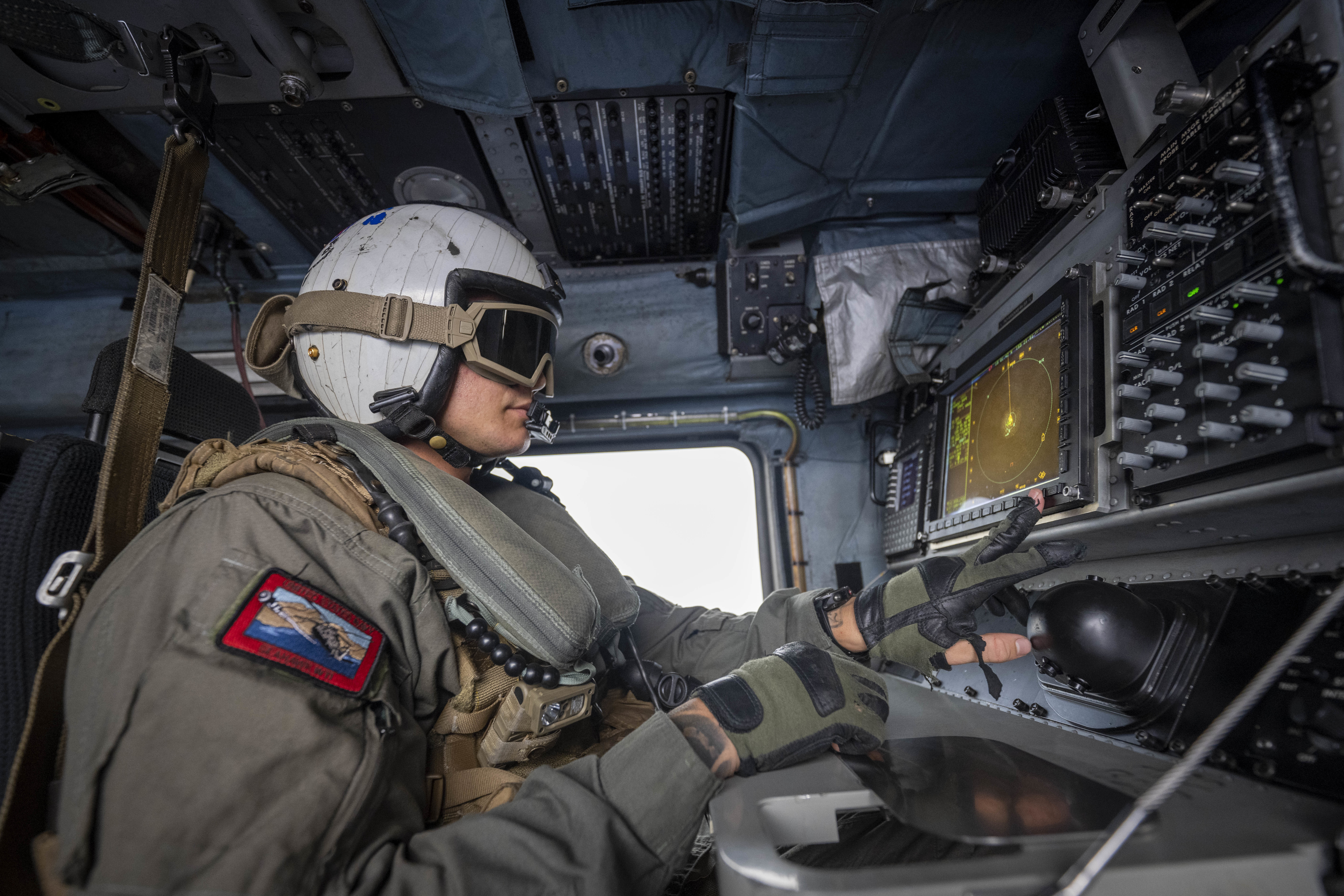
The Romeo also packs a kinetic punch – somewhat lacking in the Legend class – via missiles. It’s able to carry eight AGM-114 Hellfire missiles, four each from each right-side and left-side extended pylon, if so equipped. It can also carry torpedoes and 50 cal. guns. It is unclear how the Romeo embarked with the Midgett was armed, but a former Naval Aviator who flew those helicopters told The War Zone that storing the missiles aboard a Legend-class Cutter might prove problematic. In a photograph provided by the Navy of the Romeo landing on the Midgett, the helicopter did not appear to be equipped with the extended stores pylons.
But overall, the design of the Romeo variant of the Seahawk also makes it a good fit for working with the Coast Guard. Its foldable rotors and tail allow it to be kept safe in the hangar of Legend-class cutters like Midgett.
RIMPAC Success
For 26 days, the MH-60R embarked with Midgett during RIMPAC.
“The pairing offered an opportunity to test and evaluate shipboard helicopter interoperability and joint tactics, techniques, and procedures, as well as train for joint operations in the maritime domain,” the Coast Guard told The War Zone. “Shipboard MH-60R operations were used in Search and Rescue, Maritime Interdiction Operations, and other exercises. Additionally, the aircraft’s advanced sensor capabilities provided an opportunity to employ new and innovative command & control, maritime domain awareness, and targeting capabilities.”
The test was deemed a success.
“The successful test gave valuable information that the Coast Guard and Navy can use for joint operations moving forward,” according to a release from U.S. Indo-Pacific Command (INDOPACOM), which oversaw RIMPAC. “During the exercise, Midgett also conducted flight operations with helicopters from the FS Prairial and Guided-Missile Destroyer Chafee. Cross-deck flight operations improve the safety of future rescue and assistance operations.”
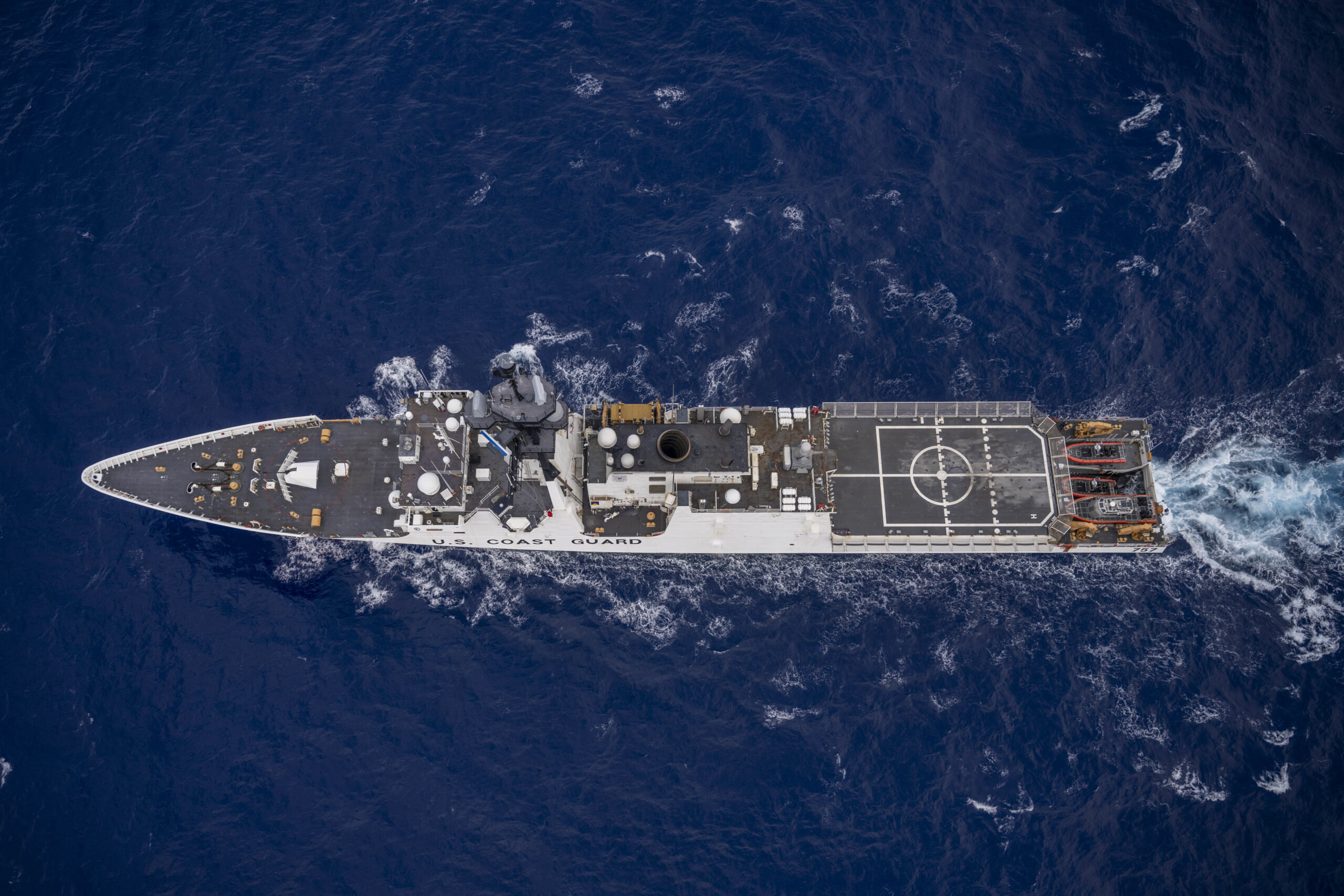
The Midgett’s crew also collaborated with U.S. Coast Guard Cutter William Hart, Japan Maritime Self Defense Force flattop Izumo, and the Wasp-class Landing Helicopter Dock Essex “to find, recover, and provide medical assistance to 10 simulated people in the water,” according to INDOPACOM.
Following the mass rescue operation, Midgett’s commanding officer, Capt. Willie Carmichael, served as commander of Combined Task Force 175, consisting of the Midgett, Chafee, Arleigh-Burke-class Destroyer Gridley, French Navy Frigate FS Prairial, and Peruvian Navy BAP Guise, “the first time a Coast Guard Cutter has led one of the RIMPAC task forces.”
The task force completed “a broad spectrum of warfighting and humanitarian assistance and disaster response operations focused on improving interchangeability and coordination with partner and ally countries.”
Boat crews from Midgett also conducted “non-compliant vessel pursuit demonstrations” with crewmembers from the FS Prairial and U.S. Navy ships.
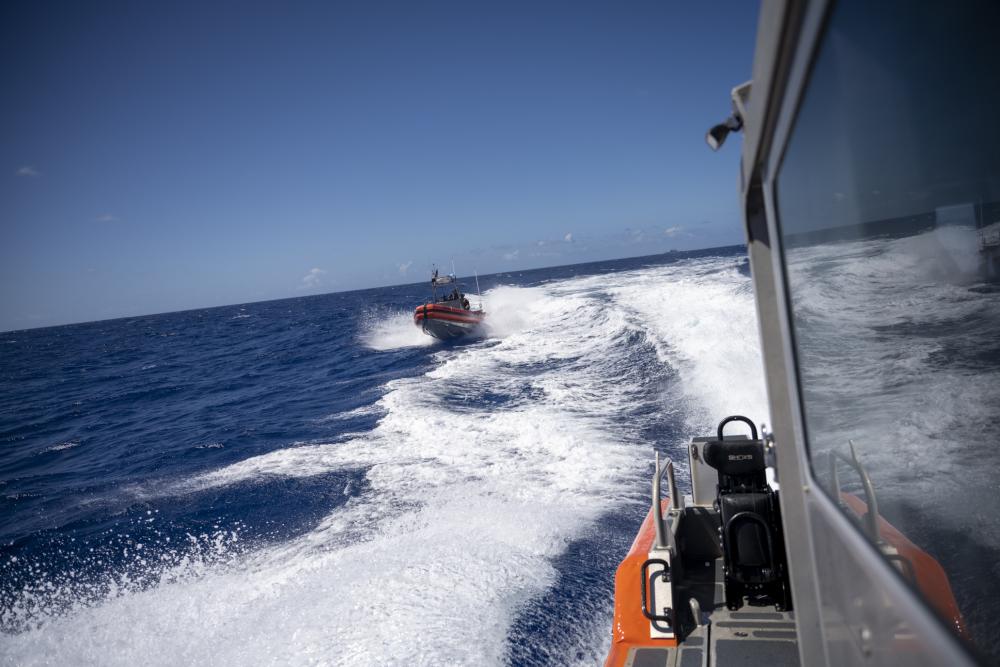
“The tactics demonstrated are essential in Coast Guard counter-smuggling operations, as well as in enforcing safety and security zones. French and Navy warships frequently assist with counter-smuggling operations in the Eastern Pacific, the Indian Ocean, and the Caribbean.”
In the second portion of the at-sea exercise, Midgett played the role of opposing force using shipboard radar, the embarked helicopter, and the Link 16 datalink system “to track and hunt other task force ships.” The cutter earned nine “constructive kills,” providing targeting information to allied assets resulting in immediate simulated strikes. This phase of the partnership included vessels and assets from the U.S., Japan, Australia, Chile, India, Indonesia, Mexico and South Korea, though the exercise took place in the waters around a fictional nation invented for the exercise.
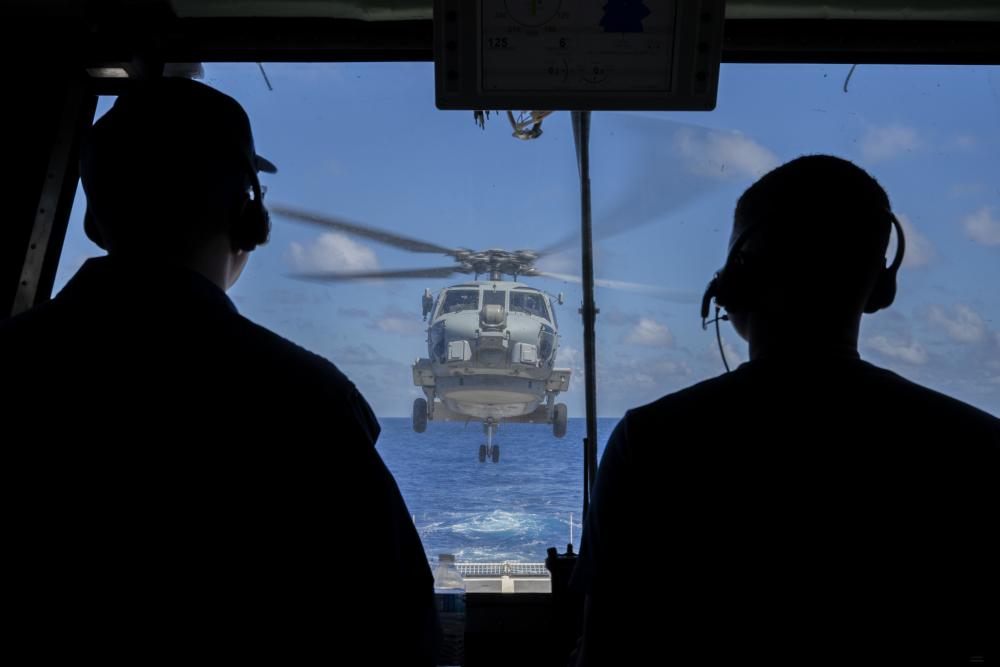
Following RIMPAC, Midgett is departing on a Western Pacific patrol, focused on “supporting maritime governance in the western Pacific, reaffirming and publicly demonstrating alignment with the multinational Rules-Based International Order in the region.”
“It was an honor to represent the U.S. Coast Guard and work alongside and build mutual trust with capable and adaptive partners during RIMPAC 2022,” Carmichael said.
“Leading a combined task force and supporting the humanitarian and disaster relief mass rescue operation showcased the relevance of U.S. Coast Guard’s capabilities and interoperability with our partner naval services.”
Tri-Service Integration
The RIMPAC test is the latest real-world application of how the Coast Guard, Navy and Marine Corps plan to project maritime power together going forward. A report released in December 2020, called “Advantage at Sea,” lays out the tri-service strategy for joint distributed operations against neer-peer and smaller adversaries alike. It read, in part:
“Several nations are contesting the balance of power in key regions and seeking to undermine the existing world order. Significant technological developments and aggressive military modernization by our rivals are eroding our military advantages. The proliferation of long-range precision missiles means the United States can no longer presume unfettered access to the world’s oceans in times of conflict.
Since the beginning of the 21st century, our three Sea Services have watched with alarm the growing naval power of the People’s Republic of China and the increasingly aggressive behavior of the Russian Federation. Our globally deployed naval forces interact with Chinese and Russian warships and aircraft daily. We witness firsthand their increasing sophistication and growing aggressiveness. Optimism that China and Russia might become responsible leaders contributing to global security has given way to recognition that they are determined rivals. The People’s Republic of China represents the most pressing, long-term strategic threat.“
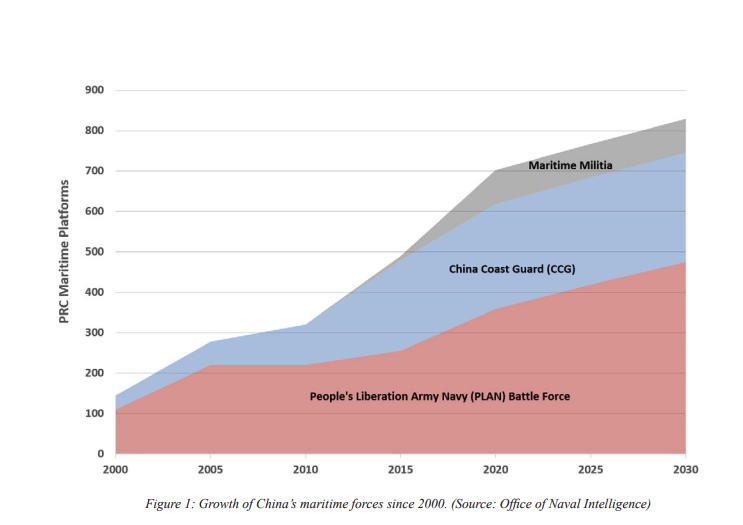
The document spells out how the three services should be properly equipped and prepared to deter, and fight, a high-end opponent like China or Russia. It also highlights how these services can expect to experience greater aggression and other geopolitical friction that may not rise to the level of an actual conflict, nevertheless hostile actions that will need to be dissuaded.
It also lays out a strategy for operations outside of conflict that is only likely to prompt more of this kind of friction.
“Navy and Coast Guard ships conduct freedom of navigation operations globally, challenging excessive and illegal maritime claims. Coast Guard cutters and law enforcement detachments aboard Navy and allied ships exercise unique authorities to counter-terrorism, weapons proliferation, transnational crime, and piracy,” the tri-service strategy says. “All three services enforce sanctions through maritime interdiction operations, often as part of international task forces.”
We covered that report in great detail, which you can read about here.
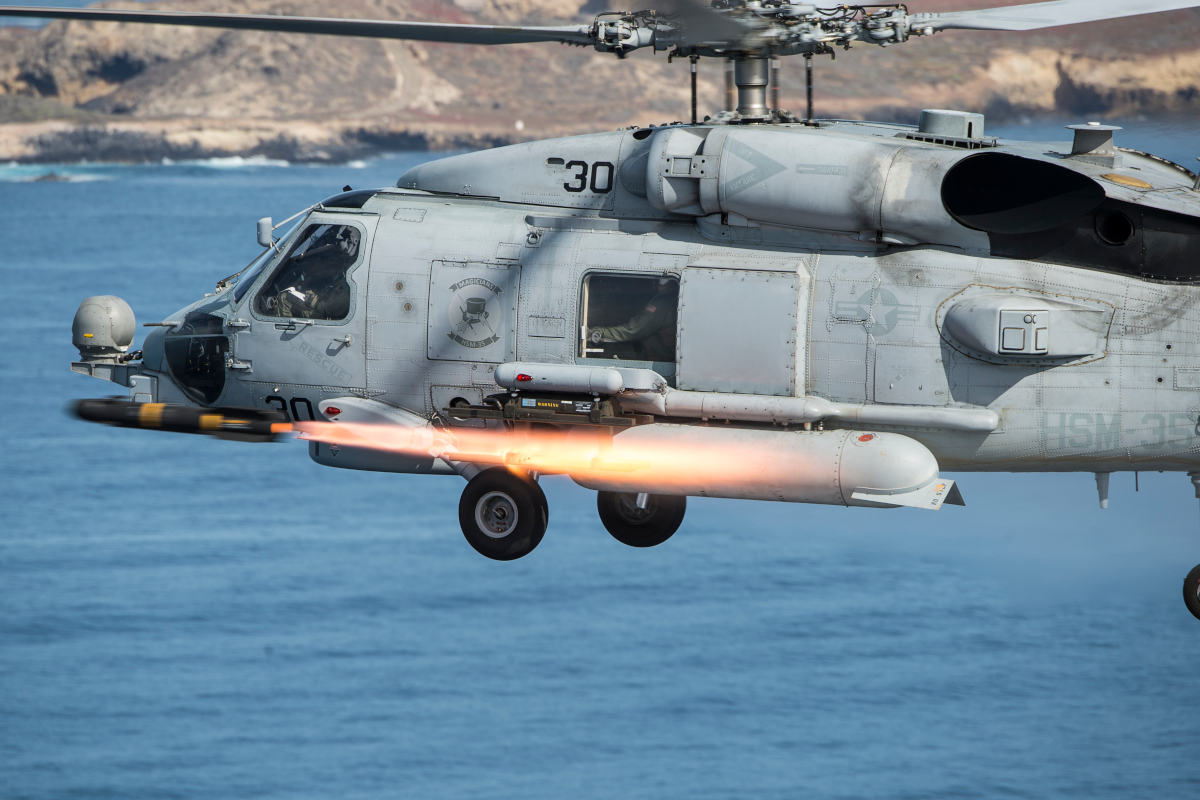
The Coast Guard told The War Zone that though all three services have long worked together, “today’s security environment demands deeper cooperation.”
“Integrated All Domain Naval Power — synchronizing the complementary capabilities, capacities, roles, investments, and authorities of the Naval Service — multiplies the traditional influence of sea power to produce a more competitive and lethal total force. Together, we expand our ability to deliver effects across the competition continuum and in all domains: from the sea floor to space; across the world’s oceans, littorals, and coastal areas ashore; and in the information environment, cyber domain, and electromagnetic spectrum.”
Embarking a Romeo aboard a cutter could address issues laid out in the document in several ways, especially enhancing the sensing capabilities of a vessel that helps fill in the gaps between what the Navy can provide and the massed array of the Chinese Navy and its auxiliary merchant marine, coast guard and fishing fleets.
“It gives you weapons and observation,” a retired Navy aviator who flew the Romeos, told The War Zone.
The helicopter “gets there faster than a Coast Guard vessel can because of its maximum speed and you can see the horizon further out, giving the crew better situational and battlespace awareness.”
That awareness would be boosted by the Romeo because it “brings radar, dipping sonar and a very good ESM suite for detecting, localizing, tracking, and ID’ing over-the-horizon emitters,” the former Navy aviator said.
All that could augment what the Legend-class cutters, currently the Coast Guard’s most powerful, already bring to the table.
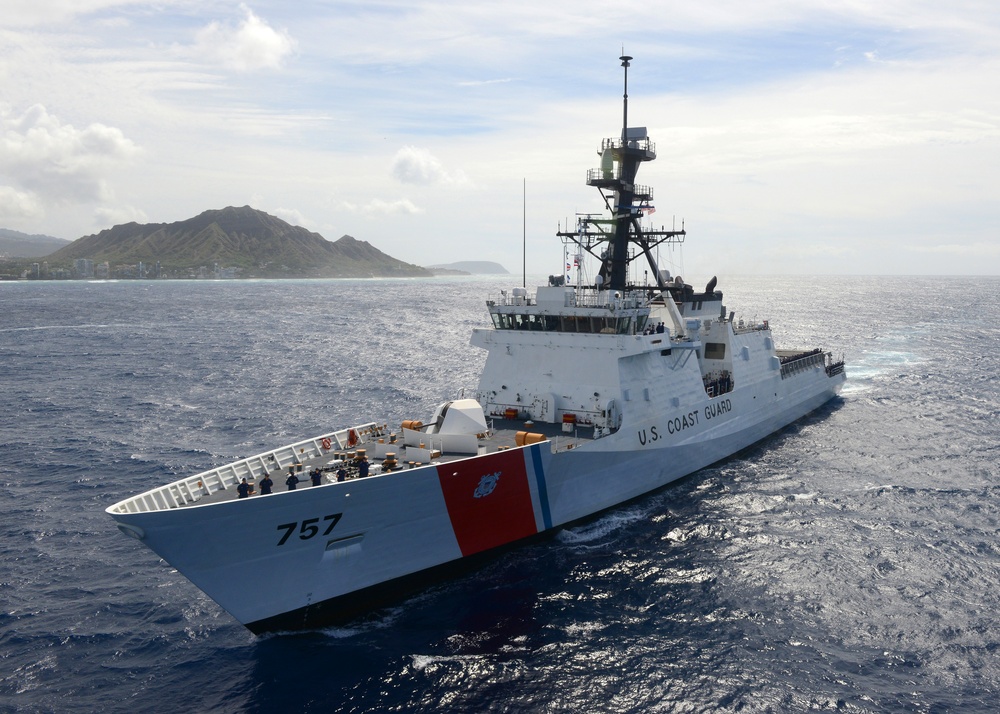
They are equipped with a 57mm deck gun, a Phalanx close-in weapon system (CIWS), and some smaller machine guns. SPQ-9B fire control radar and AN/SPS-79 search radar provide surveillance for miles around the ship, and high-powered optical systems back them up. They also have the AN/SLQ-32V2 SEWIP electronic warfare suite as well as NULKA and SRBOC decoys. Two hangar bays for a pair of helicopters or a helicopter and a handful of drones is situated near the ship’s flight deck. The stern has a launch and recovery area for large rigid-hull inflatable boats, as well.
Whether this new experiment translates into a more permanent helicopter embarkment program between the Navy and the Coast Guard remains to be seen.
The Coast Guard told The War Zone that the Romeo’s voyage aboard Midgett during RIMPAC “advanced the Tri-Service Maritime Strategy through creative and scalable aviation capabilities in operational environments along the spectrum of competition and/or conflict.”
“The aircraft deployment enabled sophisticated command and control capabilities including an integrated tactical data link, MH-60R surface search radar, and additional advanced communications capabilities. Future operations with established interoperability will enhance both Coast Guard and Navy tactical mission execution.”
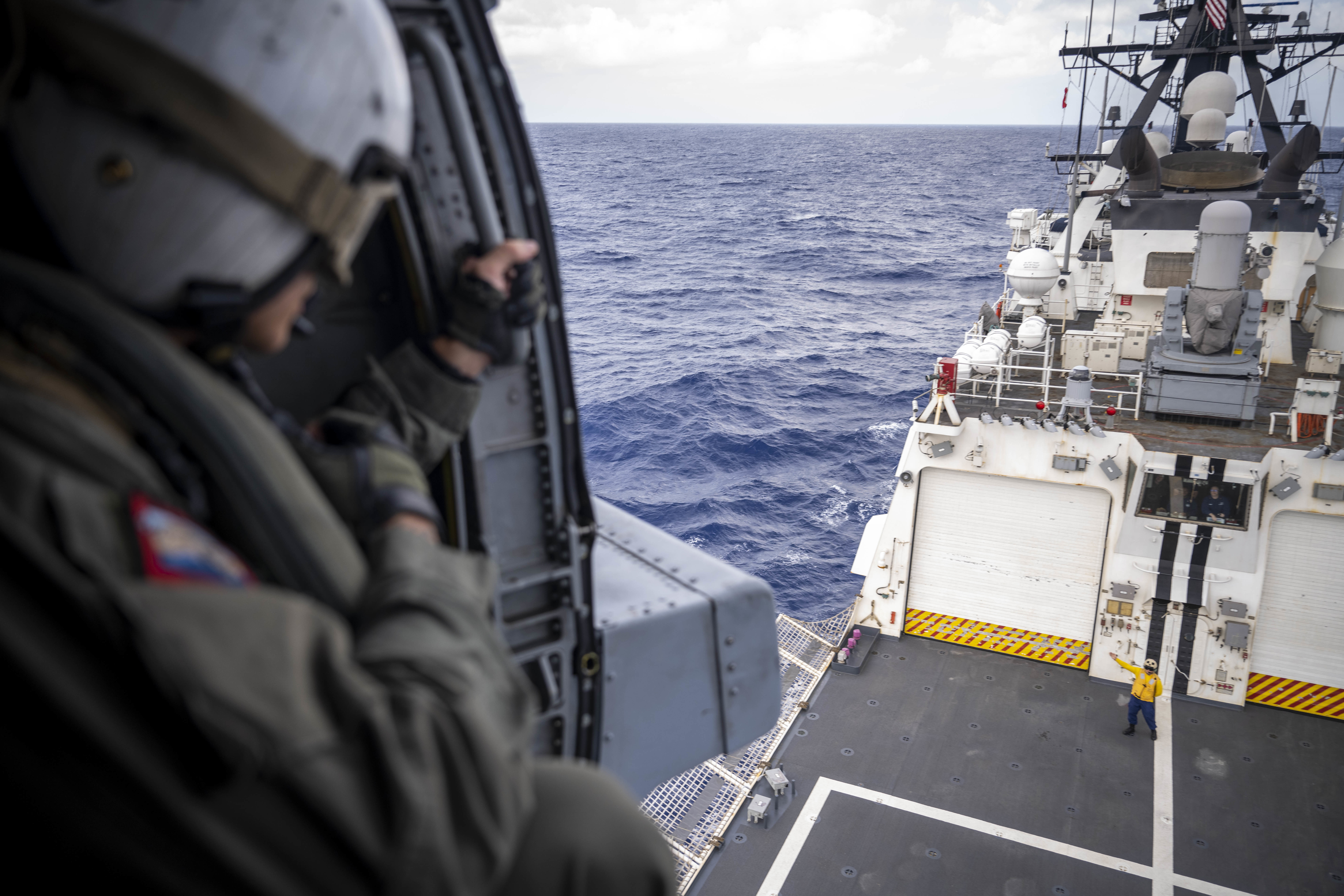
As the Tri-Service 2020 strategy indicates, the need may be there. And the Coast Guard is no stranger to plying waters potentially contested waters, even transiting the Taiwan Strait, which recently became the focal point of global concern over Chinese live-fire drills in reaction to the Aug. 2 visit by House Speaker Nancy Pelosi (D-Calif).
But can a Navy helicopter be sustained over a long haul aboard a Coast Guard cutter? And, if successful, would the availability of the MH-60Rs give far-deployed Coast Guard vessels a viable, force-multiplying airborne platform?
As retired Navy and Coast Guard pilot Doug Atkins told The War Zone, the Coast Guard has a very capable fleet of Tango variants of the MH-60. The Coast Guard has 45 of these, called the Jayhawk.
But, armed with, at most, just a 7.62 mm machine gun and a .50-caliber rifle, the latter of which can be used to disable engines on noncompliant go-fast vessels, they don’t possess the same firepower as the Romeos. When it comes to sensor capabilities and mission sets, there is absolutely no comparison. The Jayhawk is a search and rescue aircraft for totally permissive environments. The MH-60R is just a different animal entirely. Besides, the Jayhawks are heavily committed to the Coast Guard’s role as the nation’s primary coastal search and rescue air wing.

Still, the Coast Guard is in the process of giving the Jayhawks rotor and tail folding capabilities, like the Seahawks, so that they can be stored aboard cutters.
“Polar security cutters, when you think about the distance they operate, that extra three-four hours of operating parameter, that would serve itself well when you get down to Antarctica,” which the Coast Guard did in 2019 to perform treaty inspection for the first time in more than 20 years, Commandant Adm. Karl Schultz said during his March, 2021 State of the Coast Guard speech.
Still, these would be used for the search and rescue, basic surveillance, and utility roles, not like the highly weaponized Romeos.
There can be no doubt that an MH-60R gives the Legend class far sharper teeth and more powerful eyes and ears than it has ever had before. While Coast Guard cutters have featured heavy, long-range weaponry for periods of time before, the addition of the MH-60R on certain patrols seems like a highly logical fit that will allow these ships to make the best out of their forward presence operations.
Contact the author: howard@thewarzone.com
